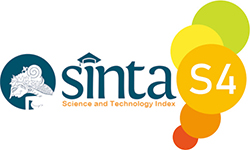DOES THE RISK DISCLOSURE DECREASE COST OF DEBT?
Empirical study on Consumption Sector Companies Listed on the Indonesia Stock Exchange for the period of 2019 to 2022
DOI:
https://doi.org/10.35794/jmbi.v11i1.54643Abstract
This research aims to find out whether Risk Disclosure can reduce debt costs for public companies in Indonesia, especially for consumption sector companies. The period in this research is 2019 to 2022. Risk Disclosure is measured using content analysis.
The hypothesis was tested using panel data regression analysis with a Random Model and adding control variables consisting of Return On Equity, Leverage, Firm Size, and proportion of independent commissioners.
The results of this research indicate that risk disclosure has a positive effect on the cost of debt. This means that the higher risk disclosure does not reduce the cost of debt, but even increases the cost of debt. This finding is contrary to the hypothesis which states that risk disclosure has a negative influence on the cost of debt. The control variables that influence the cost of debt are Company size and the proportion of independent commissioners, while Return On Equity and Leverage do not influence the cost of debt. These findings provide a reference about the consequences of risk disclosure on the Company's cost of debt. Research on the cost of debt is very relevant in Indonesia because many companies still rely on creditors for funding.
Keywords: Cost of Debt, Risk Disclosure (RD), consumption sector.
References
Abdi, H. & Omri, M.A.B. (2020). Web-based disclosure and the cost of debt: MENA countries, Journal of Financial Reporting and Accounting, 18 (3), 533-561.
Alamsyah, F., Saerang, I.S., Tulung, J. E. (2019). Analisis Akurasi Model Zmijewski, Springate, Altman, dan Grover Dalam Memprediksi Financial Distress. Jurnal EMBA : Jurnal Riset Ekonomi, Manajemen, Bisnis dan Akuntansi 7(2). https://doi.org/10.35794/emba.v7i2.49101
Alshirah, M., Alshirah, A. & Lutfi, A. (2021). Audit committee’s attributes, overlapping
memberships on the audit committee and corporate risk disclosure: evidence from Jordan”,
Accounting, 7 (2), 423-440.
Alshirah, M. & Alshira’h, A. (2023). The impact of corporate ownership structure on corporate risk disclosure: evidence from an emerging economy, Competitiveness Review, Vol. ahead-of-print No. ahead-of-print. https://doi.org/10.1108/CR-01-2023-0007
Amrah, M.R. & Hashim, H.A. (2020). The effect of financial reporting quality on the cost of debt: sultanate of Oman evidence. International Journal of Economics, Management and Accounting, 28 (2), 393-414
Azarberahman, A., Pakdelan, S., Akbari, S., & Azarberahman, J. (2021). Does Risk Disclosure
Affect Firm's Cost of Capital?. International Journal of Management, Accounting and Economics, 8(11), 816-837. DOI: 10.5281/zenodo.5988549
Botosan, C.A. (1997). Disclosure level and the cost of equity capital, The Accounting Review,
(3), 323-349.
Core, J.E., Hail, L. & Verdi, R.S. (2015). Mandatory disclosure quality, inside ownership, and cost of capital, European Accounting Review, 24 (1), 1-29.
Cormier, D., Ledous, M.J. & Magnan, M. (2011). The informational contribution of social and environmental disclosures for investors, Management Decision, 49 (8), 1276-1304.
Diamond, D.W. & Verrecchia, R.E. (1991). Disclosure, liquidity, and the cost of capital, The Journal of Finance, 46 (4), 1325-1359.
Easly, D. & O’ Hara, M. (2004). Information and cost of capital, Journal of Finance, LIX (4), 1553-83.
Eliwa, Y., Aboud, A. & Saleh, A. (2019). ESG practices and the cost of debt: evidence from EU countries, Critical Perspectives on Accounting, 68, 13-41, 102097.
Elshandidy, T., & Neri, L. (2015). Corporate Governance, Risk Disclosure Practices, and Market Liquidity: Comparative Evidence from the UK and Italy. Corporate Governance, 23(4), 331–356. doi:https://doi.org/10.1111/corg.12095
Gerwanski, J. (2020). Does it pay off? Integrated reporting and cost of debt: European evidence. Corporate Social Responsibility and Environmental Management, 27 (5), 2299-2319.
Gietzmann, M. & Ireland, J. (2005). Cost of capital, strategic disclosures and accounting
choice, Journal of Business Finance and Accounting, 32 (3/4), 559-634.
Jensen, M., & Meckling, W. (1976). Theory of the Firm: Managerial Behavior. Agency Costs and Ownership Structure. Journal of Financial Economics, 3 (4), 305-360.
Khlif, H. & Souissi, M. (2010). The determinants of corporate disclosure: a meta-analysis,
International Journal of Accounting and Information Management, 18 (3), 198-219.
Leuz, C. & Verrecchia, R. (2000). The economic consequences of increased disclosure. Journal of Accounting Research, 38 (1), 91-124.
Lopes, A.B. & de Alencar, R.C. (2010). Disclosure and cost of equity capital in emerging markets: the Brazilian case. The International Journal of Accounting, 45 (4), 443-464.
Linsley, Philip M., & Philip J. Shrives. (2006). Risk Reporting : A Study of Risk Disclosure in the Annual Reports of UK Companies. The Bristish Accounting Review, 38, 387- 404
Luo, W., Guo, X., Zhong, S. & Wang, J. (2019). Environmental information disclosure quality, media attention and debt financing costs: evidence from Chinese heavy polluting listed companies. Journal of Cleaner Production, 231, 268-277.
Muttakin, M.B., Mihret, D., Lemma, T.T. & Khan, A. (2020). Integrated reporting, financial reporting quality and cost of debt. International Journal of Accounting and Information Management, 28 (3), 517-534.
Nahar, S., Azim, M., & Jubb, C. (2016). Risk Disclosure, Cost of Capital and Bank Performance. International Journal of Accounting & Information Management 24(4) , 476-494.
Najah, A. & Jarboui, A. (2013). Extra-financial disclosure and the cost of debt of big French companies. Business Excellence and Management, 3 (4), 57-69.
Pitoy, R. R., Saerang, I. S., & Tulung, J. E. (2022). Reaksi Pasar Modal Terhadap Disahkannya RUU Cipta Kerja Menjadi Undang-Undang Pada Emiten Perbankan. JMBI UNSRAT (Jurnal Ilmiah Manajemen Bisnis Dan Inovasi Universitas Sam Ratulangi)., 9(1). https://doi.org/10.35794/jmbi.v9i1.40783
Puspaningrum, W., & Taswan (2020). Pengaruh Ukuran Perusahaan, Likuiditas, Leverage, dan Profitabilitas terhadap Risk Management Disclosure, Jurnal Bisnis dan Ekonomi, 27 (2), 163-178.
Riskanah, D., & Juliarto, A. (2019). Analisis Pengaruh Pengungkapan Risiko Perusahaan terhadap Biaya Modal Ekuitas dan Kinerja Perusahaan. Diponegoro Journal of Accounting, 7(4).
Raimo, N., Caragnano, A., Mariani, M. & Vitolla, F. (2021). Integrated reporting quality and cost of debt financing. Journal of Applied Accounting Research, 23 (1), 2022, 122-138. DOI 10.1108/JAAR-04-2021-0097
Solomon, J.F., Solomon, A., Norton, S.D. & Joseph, N.L. (2000). A conceptual framework for corporate risk disclosure emerging from the agenda for corporate governance reform. The British Accounting Review, 32 (4), 447-478.
Shad, M.K., Lai, F.W., Shamim, A. & McShane, M. (2020), The efficacy of sustainability reporting towards cost of debt and equity reduction. Environmental Science and Pollution Research, 27 (18), 22511-22522
Supriyadi, A., & Setyorini, C. T. (2020). Pengaruh Pengungkapan Manajemen Risiko terhadap Nilai Perusahaan melalui Kinerja Keuangan di Industri Perbankan Indonesia. Owner: Riset dan Jurnal Akuntansi, 4(2), 467-484.
Tulung, J. E., Saerang, I. S., & Pandia, S. (2018). The influence of corporate governance on the intellectual capital disclosure: a study on Indonesian private banks. Banks and Bank Systems, 13(4), 61-72.
Utami, C. C. A., & Ratmono, D. (2019). Pengaruh Pengungkapan Risiko Terhadap Biaya Modal Ekuitas dan Kinerja Bank. Diponegoro Journal of Accounting, 7(4).
Watts, R.L. & Zimmerman, J.L. (1986). Positive Accounting Theory, Prentice Hall, Englewood
Cliff, NJ.
Verrecchia, R.E. (1983). Discretionary disclosure, Journal of Accounting and Economics, 5, 179-194.
Zhang, L. & Ding, S. (2006). The effect of increased disclosure on cost of capital: evidence from China, Review of Quantitative Finance and Accounting, 27 (4), 383-401.









